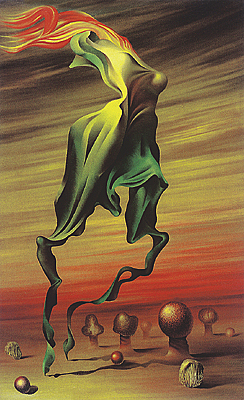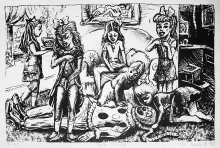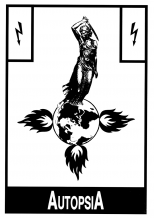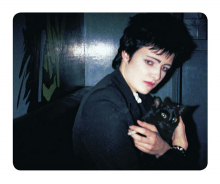| Umělec magazine 1997/6-7 >> An Exhibition from Another World The Czech Imaginative Art | List of all editions. | ||||||||||||
|
|||||||||||||
An Exhibition from Another World The Czech Imaginative ArtUmělec magazine 1997/6-701.06.1997 Tomáš Pospiszyl | reviews | en cs |
|||||||||||||
|
"The Czech Imaginative Art in the Rudolfinum Gallery is an impressive event. Hundreds of works by several dozens of artists are on show here. Most of the artists worked in the last one hundred years. What looks like a fixed museum collection by this description aims to present the work of art historian František Šmejkal who died nine years ago, and especially his concept of imaginative art as the backbone of Czech art of the 20th century.
It is not easy to write about this exhibition for several reasons. When it was too late to turn down the assignement, I realized the deceptive and difficult character of my promise to write about the show. Daily press published mainly critical reviews and neither I will write that the exhibition was a successful project. The question is what or who should be criticized. The person who deserves the least of criticism is František Šmejkal himself. His texts in the book accompanying the exhibition were written between the 60‘s and the 80‘s and they represent one of the few attempts at synthetic evaluation of Czech art of the 20th century as a whole. His writing is clear as Šmejkal is one of the lucky art historians who possessed talent to write even though he sometimes uses such general and great words that their content is lost (emphasizing the importance of authenticity of artwork and profound psyche of an artist). His texts sometimes tend to authoritarian and demagogical evaluation and superficial rejection of art trends which do not suit his concept or just are one of his favorites. But who’s not guilty may throw a stone. The important thing is that Šmejkal managed to outline the imaginative line as objectively existing trend in Czech art in quite convincing manner. Jana Šmejkalová, curator of the exhibition, reconstructed the exhibition and the book from her husband’s estate. She did so with honor and dutifully; she must have spent a lot of time and effort organizing the exhibition. What should be a subject of criticism is Czech art itself and its imaginative line. It is a task I do not dare carrying out, I may only suggest a few points and make a few comments. Imaginative art is, without a doubt, a significant feature of Czech art of the last one hundred years. The question is whether we may consider this position the most ideal one. A sound into one’s own imagination may just as well be represented by long sleep which strips the art off possible topical and concrete relations to the world. It is typical that the rise in imaginative work occured in periods when Czech art as a whole was isolated from international development or in works of artists who retrieved to seclusion. The Rudolfinum exhibition also shows how easily similar works give in to various clichés. There were many paintings which were made as if following one formula: a flat landscape is painted on the canvas and above it hangs dramatic and peculiar colored sky. On this strange set are things such as stone women, Greek architecture or ocean plants. The paintings often contain elements such as hair and gigantic draperies which may float in constantly present imaginative breeze. This whole new world is governed by laws that are differnet to the gravity law - even obviously heavy objects tend to levitate above the earth. Also of importance are dark black shadows coming from any significant object in sharp angles. Czech imaginative art is from what I know a popular exhibition with the audience. Even some of my colleagues with who I studied art history at the Philosophical Faculty consider this collection the reason why they even got involved in art history. A large part of the population considers this trend in Czech art a prototype of art. The proof of this may be found in many restaurants and buffets and in poster shops. The world of contemporary kitsch is surprisingly comparable to the best imaginative works - misty landscapes of individual dreaming, another, nicer world whose connection points with the world we live in are minimal. But the dreamy red room with a whimpering midget requires a quiet little town of Twin Peaks to balance it out and make it at least a little bit believable. What decorates many restaurant walls and unforturnately walls of the Rudolfinum gallery is a view into a world that does not concern us and may serve as a perfect decoration. This is of course unjust derogation and generalization but I believe that one of the exhibition’s contributions is that it shows how imaginative expression may be perverted into en empty and mechanically created kitsch. Artists such as František Muzika and Mikuláš Medek did not escape this situation. In a certain way, this exhibition should include also works by Josef Vyleťal and Kurovský. It would be interesting to find out in their case whether we would be able to apply Šmejkal’s requirement of authenticity as criterion of quality. A painting may be perceived in many different ways. Similarly, in a baroque church we can see sculptures, paintings and frescos, golden rays cut out of wood pierce into the nave. The whole space is conceived as a theater, a stage where we can see God even if we’re not religious. The paradox is how difficult it is to not see these ilusory elements and perceive the building as architecture made of bricks and stone which has its ground plan and engineering solutions. Yet it is impossible to say whether one or the other way of looking at a church is better or worse than the other. Thousands of religious people have been experiencing ecstasy in baroque churches just as the architect had a good feeling about the building’s structure. It is intolerant to poke at kitsch which is playing a role of art for thousands of people. We could just the same way ask why it is paintings by František Muzika which attracts the biggest crowds of people. The exhibition naturally includes a number of exceptional works but there are also examples which are harmed by being described as imaginative. Isn’t Vladimír Boudník’s work exciting especailly for its focus on objects? What František Šmejkal writes about Boudník and his relationship to action painting does correspond with my understanding of both Boudník and action painting. American action painting is in sharp contrast to any imagination, its revolutionary character is in its anti-imaginativeness. I belive that Boudník is most interesting for the position in which we may compare him - even though never identify - with early works by Rauschenberg who radically rejected possible illusive and imaginative reading of his pieces. Post-war Europe was, too, typical for its new relation to reality as the only possible and uncompromised base for art production. Nearly all artistic disciplines show tendency to capturing and possibly plain presentation of surrounding world, be it works by Italian, French poster-makers, film neo-realism, Bondy and Bialoszewski’s poetry, Robbe-Grillet’s novels, Arman’s assemblages. I believe that Boudník is part of this European stream of „neo-realism“ as well. The exhibition provokes to get back to the issue of reading Czech informel painting. Do Tomalík’s and Piesen’s paintings really possess undeniable symbolic meanings? Can we just perceive them as matter on its own, content-free wrinkled surface whose depth ends where the deepest wrinkle goes? The Czech Imaginative Art exhibition may be compared to another show entitled Grotesqueness in Czech Art of the 20th Century which was organized by Alena Pomajzlová ten years ago. Even though her exhibition was not so large as to its scope, it worked with aproximately the same period of history and some of the artists and even works presented were identical with the Imaginative Art show. How much better was the grotesquness exhibition! The phenomenon of grotesqueness itself is very closely tied to the stream of imaginative art, Šmejkal himself admitted. So many of the works in Rudolfinum, howerver, lack any sense of humor! How refreshing could be at least a glimpse of a joke! One of the most influential modernist theoreticians of the whole 20th century, Clement Greenberg and his ideas represent nearly perfect antithesis to František Šmejkal. Greenberg couldn’t stand surrealism and everything that could be described as imaginative art. His construction of what is modern art - basically unparalleled yet - does not allow any space for Šmejkal’s phantasy. Greenberg’s authoritative approach resulted in opposition of other generations of art historians, useless criticism and a fact that post-greenberg historians were interested in the type of art which did not fit in Greenberg’s perception of art. This may be shown on the example of Rosalinda Krass’ text on surrelism. If Greenberg and Šmejkal did not get along, would there be more of understanding between Šmejkal and Krauss who was of the same generation? I’m afraid there wouldn’t be much harmony between them. Krauss is interested in tension between imagination and existing world, in connecting points where individual world and freedom clash with external reality. Her texts are also based on rigorous formalist analysis of the given works whereas Šmejkal usually ends up in unfruitful psychological and moralist evaluations.( pages 36 through 37)"
01.06.1997
Recommended articles
|
|||||||||||||
|
04.02.2020 10:17
Letošní 50. ročník Art Basel přilákal celkem 93 000 návštěvníků a sběratelů z 80 zemí světa. 290 prémiových galerií představilo umělecká díla od počátku 20. století až po současnost. Hlavní sektor přehlídky, tradičně v prvním patře výstavního prostoru, představil 232 předních galerií z celého světa nabízející umění nejvyšší kvality. Veletrh ukázal vzestupný trend prodeje prostřednictvím galerií jak soukromým sbírkám, tak i institucím. Kromě hlavního veletrhu stály za návštěvu i ty přidružené: Volta, Liste a Photo Basel, k tomu doprovodné programy a výstavy v místních institucích, které kvalitou daleko přesahují hranice města tj. Kunsthalle Basel, Kunstmuseum, Tinguely muzeum nebo Fondation Beyeler.
|

































 New book by I.M.Jirous in English at our online bookshop.
New book by I.M.Jirous in English at our online bookshop.
Comments
There are currently no comments.Add new comment